#the world's leading cause of death is impoverishment
Text
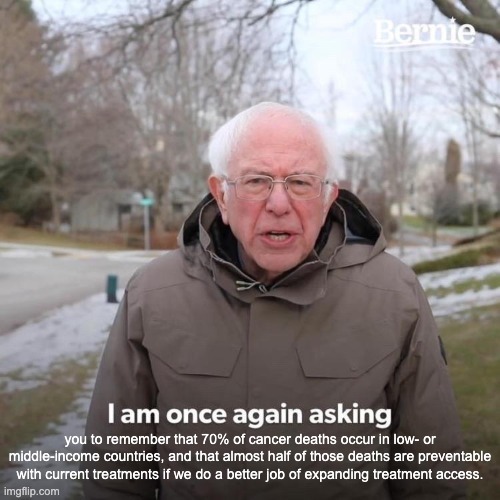
(I learned this from Hank.)
#global health#tuberculosis is not the only health problem#the real health problem is inadequate access to treatment#and fragile healthcare systems#the world's leading cause of death is impoverishment#hank green
4K notes
·
View notes
Text
I've been reading 'The Climate Book' from Greta Thunberg, and I have to talk about it. I've never seen a book written so brilliantly and desperately, pleading for awareness, for action, for survival. I thought I was aware of the climate change, but there was a vast amount of information I did not know. I'll start from the ones I did.
I knew that the climate has already changed, and will continue to change until a lot of animal species will go extinct, and a big amount of human beings will suffer, end up impoverish, misplaced, in starvation, or dead. I knew the culprits were the companies that refused to stop taking down forests, burning fossil fuels, promoting lifestyles of consumerism, over-consumption, generated the amount of waste that the planet could not safely consume or store. I also knew that one of the biggest pollutants were big oil, animal and plant agriculture, fast fashion industry, travel industry, and the capitalistic system that enabled 1% of humanity to own and over-consume 90% of the resources available to us. Knowing this made me feel powerless, because even as I boycott all of it, I can't do much else, and I'm not enough to stop what is going on. I am merely a drop in the ocean - which is what Greta points out as well. But, Greta doesn't think we're powerless.
This book is incredible in the sense that it goes over and beyond to think practically. It doesn't despair, it doesn't panic, it doesn't think any other way but how to practically and effectively bring change, what are the options and possibilities, what is true and what is propaganda, how to avoid millions of deaths and extinctions that are sure to come, if we do nothing. Greta has analyzed all action that is 'being done', and found out most of it was fraud, cheating, lying. All of the governments and companies who were bragging about reduced emissions, or offsetting emissions, have simply found ways to outsource them and to emit them in another, poorer country. The amount of emissions has actually increased.
She has also interviewed the world leaders, and people responsible and suffering from climate change - and these are the results: Nobody feels responsible, nobody feels as if it's their turn to change, to reduce, to do anything to help it. Even interviewing people whose livelihood was taken away from them due to climate change, who have lost their living environments already, their trees and animals and fields and fertility and soil, when asked if they would be willing to work ecologically from now on, with reduced or low emissions, their answer was 'Why should we? It's not fair, they took from us and enjoyed, while we suffered. We won't stop until we have what they have. We deserve it.'
With this information, Greta has found a truth of how humans influence each other - we imitate. If we see someone else doing something, or having something we find desirable, we also want it. We look at ourselves in relation to other people that surround us, we take responsibility according to what others around do, and we hold ourselves accountable only as much as others do. And this is why we have a power that goes beyond individual action, beyond simply lowering our own emissions and boycotting companies that are responsible for pollution - we are able to influence others. We're able to influence the media, which forms public opinions, and using the media, force into action those who benefit from polluting the planet.
What I didn't know, and this book taught me, was that from the times humans started to hunt, they didn't only have a great effect on the environment, they were the absolute leading agent on it. Soon after hunting the megafauna into extinction, the environment started to change not just because we affected it, but because we directed it to. We caused the extinction of many species throughout the past, by hunting, taking wild spaces for our own use, polluting water sources, changing the climate, spreading predatory species, like cats and rats, and we didn't stop there. We changed the landscapes of forests and fields, into human-used agricultural land that was effectively deadened for the purpose of wildlife. We domesticated, and then farmed animals, to such extreme degree, that right now what is left of the wildlife, is mere 12-15% of all animals out there. More than 80% of current animals by weight living on earth, are put there by animal agriculture, meant for human consumption. That is absolutely insane. We did the same with the wildlife environment as well – there is now only 3% of the forests on earth, that are still considered intact. We changed the landscape, not only slightly, but by erasing most of it, making it unusable to animals, insects or wild plants, appropriated only for agriculture, grazing, and human-only environments. And, we dug up and released so much carbon into the air, it is coming close to the amount that we had on the earth, at the time of dinosaur extinction, which wiped out a third of the planet's species. And we keep doing it, even knowing what will happen, knowing that every single time this happened in the past, it created mass extinction.
I wasn't aware how serious and extreme the changes we made were. Knowing what is going out, makes it very clear why we have a crisis, it would be crazy to expect not to have one. These changes were not reported, nobody was asked to approve of them, there were no regulations or limits, no environmental studies on consequences, and it keeps going. We keep increasing the demand for agriculture and animal products, increasing our consumption even though we are running out of the natural resources used to create the products. And it is not our fault. Most of the food and meat created by destroying this land, will go to waste, for the profit of the corporations. The world will keep living in starvation, despite so much of natural life getting destroyed for food, despite the climate crisis being caused, partly by our food production.
This doesn't mean we can't sustainably feed ourselves anymore, it just means we can't do it the way we're used to. It just tells us we need to use more resilient and less land and water consuming food. Plant based diets demand less soil and emit less carbon, gardening reduces the amount of agricultural space needed to feed us, supporting and protecting wildlife wherever it's still thriving, will save both soil, animal species, and biodiversity that is very quickly fading from the planet.
I've also learned that even as we're close to the tipping point, but haven't reached it yet. Whatever we do right now that stops us from reaching it, will mean the difference between life and death to the future generations of people, animals, and plants. If we manage to make changes now, to stop the ice from melting past the tipping point, we can save millions of lives, that would end in certain death otherwise. If we can create policies that are not volountary but binding, we have a chance to save livable land, animal and plant species, biodiversity, and human quality of life. It's not too late to act, in fact, this is the vital time to act, and we're the only ones who can do it.
And the way you can act is not just by reducing waste, reducing the amount of energy you consume, reducing animal-products in your food and refusing to waste and throw away usable goods, but by being public about it. By making it clear it's a positive improvement on your life, on your quality of life, that it's both moral and enjoyable, both inspiring and encouraging others to do the same. Some of us have bigger impact on others than we might know, and if we start doing it and visibly enjoying it, there are others who will follow.
This book has taught me immense amount of science behind the climate crisis, and gave me incentive to do more than just live and feel helpless, I need to do more. I recommend this book to anyone wanting to learn more, and wanting to act more. I will be from now on, writing more about ecology and preserving the planet, and how to do it. If we're the directors of where this planet is going, we have to be so intentionally, with knowledge, wisdom and awareness of what we are doing. We can do good, and humans have been doing good, any time there's been wisdom, awareness and intention in how we're shaping the environment. And if anyone wants the book in the audio form, send me a message and I will give it to you.
#Greta Thunberg#The Climate Book#book review#climate crisis#climate change#global warming#actions to stop global warming#impacting others to understand and prevent the worst of the worst#carbon emissions#lying politicians
598 notes
·
View notes
Text
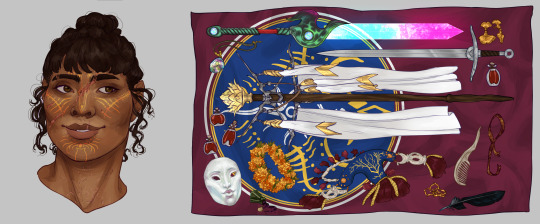


Inquisitor Ixchel Lavellan | art by @whoisnotmyname
I commissioned Mumford for a portrait and item collection for my Inquisitor and I highly recommend you do the same! I'm so happy with how my wall of muscle Champion turned out, and her items are rendered better than I could have imagined! Seeing them all laid out on her Champion's Standard makes them feel so real!
Item descriptions under the cut.
Champion's Standard. Behind everything is Ixchel's Standard, which Vivienne designed to reflect her Dalish identity and her presence as the Inquisitor. It features a modified version of the Dirthamen vallaslin, and the Inquisition eye/sword.
Chromatic Greatsword (modified). In my fic, Ixchel discovers a stash of ancient weapons from Andruil's own armory. Among them was a chromatic greatsword, which she modified with schematics from the Sulevin Blade to honor the Dalish warriors who came before her. She can deactivate the glowing blade when not in use.
Longsword. Someday she will lose her arm and no longer be able to wield the heavy greatswords that made her career. Instead, she adapts to one-handed use of more mundane blades. She knows she will lose her arm, so she carries this with her and practices with it in preparation for that day.
Dalish Banner Crown. This was something she's had since day 1 of my Inquisition playthroughs and has become synonymous with her leading troops into battle. She carries the banner with her against their foes, and brings it with her to audiences with human monarchs to make it impossible for them to forget she is a member of a race they tried to subjugate and exterminate.
Hart's Decorated Bridle. The people of Halamshiral's alienage, a mix of elves and impoverished humans, presented a special white hart to her when she arrived for the ball at the Winter Palace. He was given to her with ribbons and paintings on him to symbolize her Dalish roots, but in the traditions of Orlesian alienages. He is a proud and fancy beast and his bridle matches him.
Dorian's Talking Crystal. It no longer works--it's from her first life, in a world and timeline that no longer exist, but she keeps it anyway as a reminder. Even until the day she died, Dorian tried to hold on to her, his dearest friend.
Health Potions. Every good hero needs them!
Flemeth's Gifted (Mask). In my fic, Briala received an Orlesian courtesan's mask from a mysterious witch with directions to give it to Ixchel. The mask helped Ixchel blend in with the human crowd in Wycome on her infiltration mission. Only if one looks very, very closely can you see the subtle carvings of Mythal's own vallaslin, marking Ixchel as Dalish--and, perhaps, marking Flemeth's designs upon her future.
Spilled Deathroot Potion. Ixchel began her story with this potion--but she will not meet that end again.
Ardent Blossoms (Marigold Crown). In my fic, marigolds are an ancient symbol of Champions' dedication to their causes and their lords. Ghilan'nain wore them in honor of Andruil when she was but her honored priestess. The cempasúchil symbolize a bond to, and beyond, death. Cole found these, the Ardent Blossom, and Ixchel has named herself Champion of the People--not Champion of a lord, or a cause, but Champion of all those who need someone to fight for them. They have become a symbol everywhere of fighting for equal rights, and others wear them in their hair to show that they're willing to take the fight to the end.
Gingko Earrings. Ginkgo symbolize hope, and hope for peace, in my continuity. They've become a symbol she wears often in my art.
Halla Horn Comb. Ixchel was actually adopted by the Dalish Clan Lavellan, after growing up as a feral child in the wilderness. One of the dearest memories she has of the Clan is of the First, Terinelan, teaching her how to braid her hair. She has kept the halla horn comb ever since.
Hair Ribbon. Same as the above. In Dalish tradition, she made this ribbon and embroidered it herself.
Puzzle Ring. Given to her in the future of my fic by Solas. It's a puzzle for her ingenuity, but it's also a promise of dedication and return.
Raven Feather. Symbolizing Dirthamen, and her role as "Kin-Finder," a great title given to her upon receiving her vallaslin and acknowledging that she has uncovered, and returned, so many elven secrets lost to history due to the hardships they faced since the fall of Elvhenan.
62 notes
·
View notes
Note
“Viserys made rhaenyra his heir and his word is law” “the team black kids were accepted by viserys and laenor so their legitimate” “the team black kids are half targaryen so that’s all that matters”
I will throw you off of a damn roof
None these people understand that we’re watching a show set in the medieval era where the laws and rules were different compared to now but they still try to use modern logic to explain it. We learned this in history goddamn it
Not only are the laws, rules, customs and beliefs different, but the entire political structure is fashioned so as to uphold them! Going against them or trying to change them is notoriously difficult!
Kings only started to consolidate more power slowly as feudalism gave way to centralized bureaucracies due to a variety of socio-economical factors that are very obviously lacking in the world of ASOIAF: the development of urban centres, of the merchant class / townspeople capitalists, expansion of trade, momentous events that lead to a decline in population (like plagues or disastrous wars) -> causing a reduction in the number of peasants, meaning that the peasants who did survive were precious human resources that were not so easily replaceable and demanded more rights for themselves, crusades that impoverished a lot of nobles etc etc - all of these which eroded the power of the feudal lord and allowed kings to absorb that power for themselves.
What these people don't understand is that noble lords held a tremendous amount of power over their own lands and, in an era where travel was difficult, the "king's will" was what they made of it. Sure, the king could THEORETICALLY go to war if a vassal was being too contrarian, but he'd have to convince his other vassals to join him and provide him with an army and wars were expensive. So it was much more advantageous to negotiate with these people and compromise rather than impose oneself via violence, although that did also happen, of course.
Another important catalyst for monarchs gaining more power at the expense of nobles is the introduction of gunpowder and CANONS. Previously, castles were incredibly effective at keeping the enemy out since they were nigh impenetrable. You could only take a castle either by sacrificing a ridiculous amount of fighters, rendering it not worth it, OR by starving it out, which could take MONTHS, was expensive AF and was also not worth it. Now, with canons, if you disobeyed the king, it became a lot easier to get fucked.
Aegon V has this very problem when the nobles opposed his smallfolk policies. So what does he decide to do?? He tries to come up with his own canons, which in-universe, means bringing dragons back. And we all know how that ended.
The difference, of course, is canons are not weapons of mass destruction, whereas dragons most definitely are. So the nobles are kind of in the right here to oppose a monarch that can unleash such a devastating level of death and destruction with no checks and balances imposed on their power.
Viserys can yap all he likes how Rhaenyra is his "rightful" heir, the nobles will only say yeah right and crown Aegon after he dies. "The King's word is law" - how is it law if you do not exercise the monopoly on violence? How is it law if you cannot enforce it? The only way you could make it law in these circumstances is if you convince enough people to abide by it somehow via negotiation and debate. The "law" you're talking about remains a laughable suggestion otherwise.
#succession for the iron throne#hotd meta#ask#anon#this is most definitely a simplification i am not a medieval historian by any means - my focus is IR#these discussions are lacking a fundamental grasp on the philosophies of law and state theory#anti viserys i targaryen#team green#i am urging greens to stop pretending we are usurpers#anti hotd fandom
107 notes
·
View notes
Text
Title: The Six Most Dangerous Diseases: A Closer Look

Introduction:
In our ever-evolving world, where medical advancements are constantly being made, some diseases continue to pose significant threats to human health. These diseases, often life-threatening and difficult to treat, have claimed countless lives throughout history. In this article, we delve into the six most dangerous diseases that have left a lasting impact on global health.
1. HIV/AIDS:
Human Immunodeficiency Virus (HIV) and Acquired Immunodeficiency Syndrome (AIDS) remain one of the most dangerous diseases, affecting millions worldwide. HIV weakens the immune system, leaving individuals susceptible to opportunistic infections. Since its discovery in the 1980s, AIDS has claimed over 32 million lives, highlighting the importance of education, prevention, and access to antiretroviral treatments.
2. Malaria:
Malaria, caused by parasites transmitted through infected mosquitoes, remains a significant global health concern. It primarily affects tropical and subtropical regions, causing over 400,000 deaths annually. Efforts to control malaria include mosquito control, bed nets, and antimalarial drugs, yet challenges such as drug resistance and climate change persist.
3. Tuberculosis (TB):
Tuberculosis is an airborne bacterial infection that mainly affects the lungs but can spread to other parts of the body. With over 1.4 million deaths in 2019, TB remains a formidable threat, particularly in impoverished and densely populated areas. Multidrug-resistant TB strains pose additional challenges to treatment and eradication.
4. Ebola Virus Disease:
Ebola gained global attention due to its rapid spread and high mortality rate during outbreaks. The virus causes severe bleeding, organ failure, and death. While outbreaks are sporadic, they have proven devastating, requiring swift containment efforts and international collaboration to prevent further loss of life.
5. Cancer:
Cancer encompasses a range of diseases characterized by uncontrolled cell growth. It is a leading cause of death worldwide, with variations in incidence and mortality rates depending on the type of cancer and region. Advances in early detection, treatment modalities, and personalized medicine are crucial in the ongoing battle against cancer.
6. Cardiovascular Diseases:
Cardiovascular diseases, including heart disease and stroke, collectively account for the highest number of deaths globally. Risk factors such as unhealthy diets, lack of physical activity, smoking, and high blood pressure contribute to their prevalence. Public health campaigns promoting heart-healthy lifestyles and access to quality healthcare play a vital role in reducing the burden of these diseases.
Conclusion:
While medical progress has enabled us to better understand, prevent, and treat many diseases, the six mentioned above continue to pose significant challenges to global health. Effective strategies, international cooperation, and ongoing research are essential in addressing these dangerous diseases and minimizing their impact on individuals and communities around the world.
#disease#health#fitness#our flag means death#1950s#80s#bmw#cars#cute#barbie#drawing#ferrari#rwby#succession
3 notes
·
View notes
Text
What Is the Cause of Poverty?
When answering, “What is the cause of poverty?” it is essential to remember that there is not one factor or deficiency that leads to people living in the most desperate situations.
However, there are some common factors in many impoverished areas:

Lack of Education – How can lack of education cause poverty? Without consistent educational opportunities, children and adults are often stuck in the generational cycle of poverty. When a person doesn’t have basic reading, writing and math skills, they are often stuck in day-labor positions, and many of those do not meet the basic financial needs of a family. When we study how lack of education causes poverty, we see that it also impacts the next generation. Data gives good cause to believe that learning to read and write is one of the “great miracle cures.”[1]
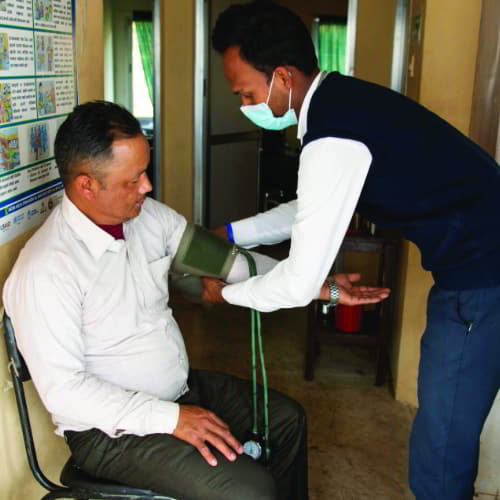
Lack of Healthcare – Chronic disease still plagues much of the impoverished world. For example, a waterborne illness like typhoid can cause mass illness in an entire community. Malaria and diarrhea are common illnesses that, when basic medical care is available, are often treated successfully. Without medical care, however, these illnesses can cause death. Clean water wells and sanitation facilities are also key to good health in a community, but they are often lacking in poorer neighborhoods.

Lack of Environmental Stability – Natural disasters and war cause vulnerability in a society long term. For example, if an earthquake hits a village and it cannot adequately recover, the impact of that earthquake will be felt for generations; the residents will be susceptible to long-term problems. Regions that often sustain natural disasters and political upheaval are known as “fragile and conflict-affected countries” (FCS) and are some of the most difficult places to fight poverty. These include South Asia and sub-Saharan Africa, chronically poor areas.[2]
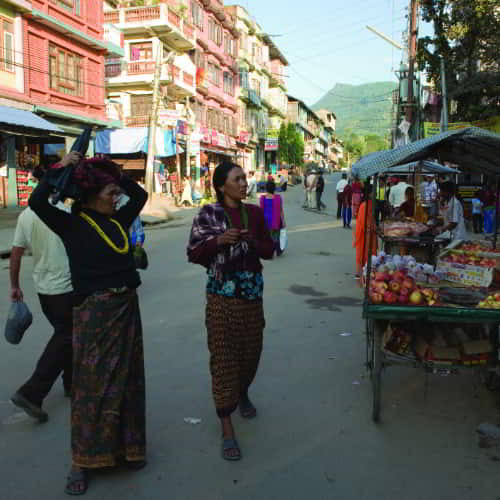
Lack of Financial Opportunity or Assistance – In some areas of extreme poverty, a person can learn to read and write but still lack the opportunity to gain a higher-paying job. There simply aren’t opportunities to use his or her skills. They may want to start a business, but there is no one to loan them money to get started.
Click here, to read more about this article.
Click here, to read more blogs in Gospel for Asia.Com
#Abject Poverty#Absolute Poverty#Bridge of Hope#Generational Poverty#GFA-Supported Children’s Ministry#GFA-Supported Workers#Gospel for Asia#Poverty Alleviation#Poverty Alleviation Program
0 notes
Text
There is so much hate and bitterness I have for the world I was born in,
Not for the people around me. Most of them at least. It’s for the systems we live in. I can’t get help for my back, my leg, my fucking hallucinations without picking between that and long-term stability. I’m in pain every day because of a job I had to take to get by the fucked me over - and I can’t get worker’s comp from it.
I hate that while I am dealing with that, families are being massacred by weapons paid for with my taxes, built by companies that thrive off of the suffering they create. That the “civilization” that is being “protected” in the United States is full of starving, sick, and impoverished people that won’t be helped by the government we’re forced to fund.
My work, my effort, my pain goes more towards causing death than it does for providing shelter, food, comfort, and medicine to those in need.
I hate the world I was born into. I wish I wasn’t.
But I am here.
I am tired, and sad, and can barely get up some stairs without wanting to scream from the pain,
But I am here.
The only people I hate are the ones perpetuating this. Who harvest human lives with lead for profit. Those who support it, who help make this world the way it is.
I want to see them burn.
0 notes
Note
Why did you guys choose the charity that you did? Of all the causes out there, what stood out to you about Maternal Mortality in Sierra Leone?
There is a lot of injustice in the world. There is injustice in every direction! It is easy to find yourself frozen in the face of the a dizzying array of injustices.
But for me, there is no expression of structural injustice as profound as mortality caused by poverty.
Like, the 1.5 MILLION people who will die this year of tuberculosis will not REALLY die of infection by the bacterium m. tuberculosis. Whether you get tuberculosis is not REALLY determined by whether you are exposed to the bacterium that "causes" TB. Whether you get sick and die of tuberculosis is determined by whether you are impoverished, whether you live in a community with a fragile healthcare system, and whether you can access healthcare. This is why most people in rich countries don't even know that TB is the second-leading cause of infectious disease death on Earth--behind only Covid.
Maternal mortality is another glaring expression of this injustice: 700 people in Sierra Leone will die giving birth for every one who dies in Germany. This is not the result of some natural or inevitable process. It is the direct result of human-built systems that have impoverished the Sierra Leonean government and people for centuries.
When we began this project in 2019, one in seventeen Sierra Leonean women died in childbirth. ONE IN SEVENTEEN. There is nothing inevitable about the statistic. (Indeed, it is now closer to 1 in 25--which is still hundreds of times higher than it needs to be.)
There is nothing inevitable about this injustice! It was caused by human-built systems and can be addressed by human-built systems. And the great thing about fighting maternal mortality is that it has all kinds of virtuous side effects--the blood bank at Koidu Government Hospital will serve those who are dying from blood loss after child birth, but it will also serve the entire community. Clean water and electricity at community health centers make for safer conditions in which to give birth, but also safer conditions in which to be treated for other healthcare issues. And of course we know that when parents survive childbirth, kids are more likely to be educated, and less likely to be malnourished.
Sierra Leone in particular has a government that, while deeply impoverished and chronically underfunded, is working to build a stronger healthcare system, and Partners in Health has deep relations with the government so that it's not working parallel to the public healthcare system but deeply embedded within it. And because SL is the epicenter of the global maternal mortality crisis, by making change there, we show the global health community that NOWHERE ON EARTH should the lifetime risk of maternal death be above 1%, let alone 5 or 7 percent.
So those are some of the reasons why we are focused with PIH on maternal mortality in Sierra Leone, and why Hank and I have committed the majority of our wealth to addressing the injustice of inequitable access to healthcare. If you want to join the thousands of folks who've joined us by donating monthly to support this cause, or learn more, here's the place.
729 notes
·
View notes
Text
What is the War on Poverty?
The term “war on poverty” is usually used to refer to expansive social legislation introduced by President Lyndon B. Johnson in the 1960s to end poverty in the United States. He introduced an “unconditional war on poverty” in his first State of the Union address in January 1964. This rhetoric quickly found its way into laws and the creation of new programs and agencies.[1] The efficacy and impact of this legislation in America are not within the scope of this article. Instead, this will be looking at the wider range of a modern war on poverty around the globe.
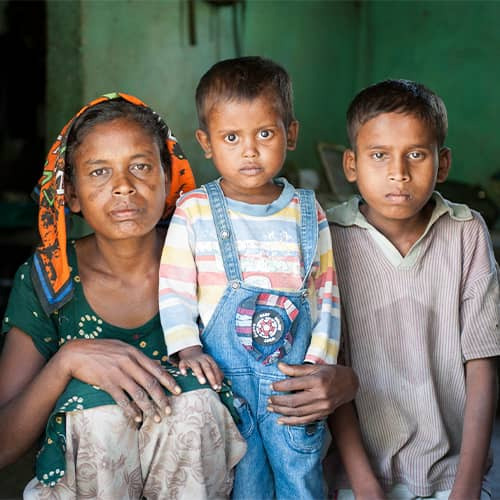
To address the issue, the question “why is poverty a problem” needs an answer. There are over 700 million people living on less than $1.90 a day, which is about 10% of the world’s entire population.[2] Poverty has dire consequences with malnutrition, contaminated water and poor sanitation and hygiene causing many preventable deaths, especially for children under five. The 2017 UNICEF Child Mortality report states that in poorer areas, one child in every thirty-six dies in their first month of life, many of them from curable diseases like malaria, diarrhea and pneumonia.[3] Of all these children living in extreme poverty, 75 percent of them live in sub-Saharan Africa and Asia,[4] which is where GFA World has focused its efforts over the last forty years and will continue to do so moving forward.
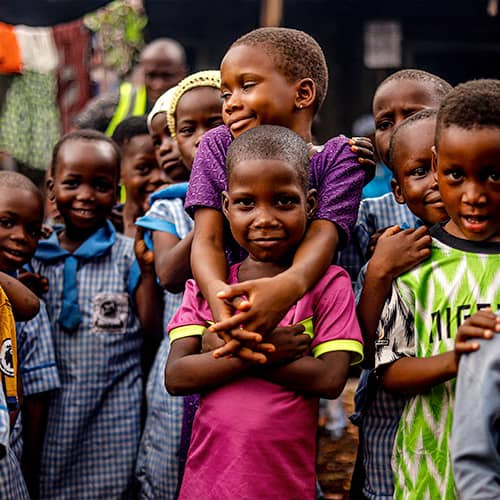
GFA World addresses food poverty with its efforts by focusing on providing children with proper education and nutrition. The task is vital because as many as one in three children in sub-Saharan Africa experiences stunted growth, not getting the vitamins they need from their food. This stunted growth impacts a child’s cognitive ability, making it even harder for them to learn in school,[5] assuming they can attend school at all. In that region alone, 32 million children—mostly girls—do not go to school.[6] Thus, one of the first initiatives GFA began in Rwanda was a branch of their child sponsorship program, which helps ensure that children get an education, food, necessary medicine and supplements. The medical ministry includes distributing vitamin A—which helps in eyesight development—and deworming tablets—which remove parasites from the body.

Worsening the food shortage is a water crisis in Africa; more than a quarter of the whole continent has no access to safe drinking water.[7] GFA World installs Jesus Wells, bringing clean water to villages and families that never had it before. Two wells have been drilled in Rwanda—with many in place in Asia already—and more are on the way in Africa. These Jesus wells can serve an average of three hundred people daily and can last around twenty years.[8]

Another way that GFA World contributes to poverty alleviation is by gifting income-generating gifts to impoverished families. These include sewing machines that men and women can use to become tailors and earn extra income. GFA also distributes farm animals, such as cows, chickens and pigs which give poor families and villages brighter hope for the future. They can use the meat and milk from the animals to better feed their kids or sell for extra money. Larger creatures can help with plowing and fertilizing crops, which increases yield and profitability. The animals reproduce, and their offspring can then be sold, leading families out of extreme poverty and substantially brightening their circumstances.[9]
Click here, to read more about this article.
Click here, to read more blogs in Gospel for Asia.Net
#Abandoned Children#Abject Poverty#Absolute Poverty#Absolute Poverty Definition#Children and Women#Children Aound the World#Children Around the World#Children in Poverty#Christian News#Christian News Sources#Christian News Today#Christian News Websites#Christian World News#Cycle of Poverty#Displaced Children#Extreme Poverty#Extreme Poverty Definition#Extreme Poverty in the World#Extreme Poverty Statistics#Generational Poverty#Latest Christian News#Poor Children#Poverty#Poverty Alleviation#Poverty Alleviation Program#Poverty and Hunger#Poverty Cycle#Poverty Issues#Poverty Reduction#Poverty Worldwide
0 notes
Text
The Silent Killer: Unveiling the Undeniable Impact of Tuberculosis on Global Health
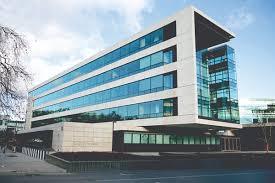
The Silent Killer: Unveiling the Undeniable Impact of Tuberculosis on Global Health
The Silent Killer: Unveiling the Undeniable Impact of Tuberculosis on Global Health
Tuberculosis or TB is a potentially fatal disease caused by a bacterium called Mycobacterium tuberculosis. While it primarily affects the lungs, it can also damage other organs such as the kidneys, spine, and brain. TB is highly contagious, spreading through the air when an infected person talks, coughs, or sneezes.
TB is a neglected disease and has been dubbed ‘the silent killer’. It is a leading cause of death worldwide, surpassing AIDS-related causes. According to the World Health Organization (WHO), 1.5 million people died from TB in 2018, with India, China, and Indonesia recording the highest number of cases. While TB was believed to be a disease of the past, developed countries have also seen a resurgence in reported cases due to an increased number of comorbidities and a growing population susceptible to infection.
TB is a significant public health concern for several reasons. It has the potential to infect anyone, regardless of age, race, or socio-economic status. In addition, the bacterium that causes TB is becoming increasingly resistant to antibiotics, making it more difficult to treat. Drug-resistant TB not only increases the duration and cost of treatment, but it also increases morbidity and mortality rates.
Beyond individual suffering, the economic and societal costs of TB are vast. It affects the poorest and most vulnerable communities, who often lack access to healthcare, nutrition, and safe living conditions. TB often leads to long-term disability, threatening individual and household incomes and wider economic growth. Additionally, the high cost of treatment and care can lead to impoverishment and a cycle of poverty, particularly in low-income countries.
Despite the urgency of TB and the availability of effective treatment options, scaling up diagnosis, and treatment remains a challenge. TB often goes undiagnosed or is diagnosed late, contributing to the continued spread of the disease. There is also a lack of investment and research in new diagnostic tools and drugs.
Fortunately, there are measures we can take to prevent and control TB. This includes identifying groups at highest risk of infection and providing education on TB prevention and treatment. Access to quality healthcare, better nutrition, and safe living conditions are important for vulnerable populations to reduce their risks of infection. Moreover, innovation and research on sharpening diagnostic accuracies and developing new drugs can be a positive way forwards in combating this deadly disease.
In conclusion, Tuberculosis remains a considerable threat to global public health. Its scale, impact on households, communities, and the economy is vast, making it a necessary disease to combat and reduce its incidence. With improved surveillance and diversion of more resources towards TB diagnosis, treatment, and prevention, we can mitigate the spread of TB and optimize its eradication efforts worldwide. #HEALTH
Read the full article
0 notes
Text
FG to increase tax on tobacco products to 50%

The Federal Government says it will increase excise tax on tobacco products from 30 per cent ad-valorem to 50 per cent as part of measures to control tobacco smoking in the country.
Head, Tobacco Control Unit, Noncommunicable Disease Division, Federal Ministry of Health, Dr Mangai Malau, disclosed this on Tuesday at the National Tobacco Control Budget Advocates Meeting in Abuja.
Malau presented a paper titled
“Overview of Tobacco Control Funding/Budgeting in Nigeria: Why Tobacco Control Budgeting and Funding?
He said that presently, the Federal Government imposed a 30 per cent tax on tobacco products but its target was to increase to 50 per cent in order to meet the World Health Organization standard.
According to him, funding for tobacco control must come majorly from taxation and there is also a need for relevant stakeholders to apply tax measures rightly if they are to address the issues of tobacco control in the country.
“In effectively controlling tobacco and tobacco products in Nigeria, funding is a critical component. The WHO Framework Convention on Tobacco Control recognises this and clearly stipulates in Article 26.
“It states that parties shall provide financial support in respect of its national activities intended to achieve the objective of the Convention, in accordance with its national plans, priorities and programmes.
“It is also important to state that funding is a major provision of the National Tobacco Control Act.
“Section eight of the Act, provides for the Tobacco Control Fund, which shall be used to fund tobacco control activities programmes and projects,” Malau said.
According to him, this meeting is therefore important as it will seek for better funding for tobacco control, in order for Nigeria to meet the objectives of the WHO FCTC and the NTC Act.
He said, “Tobacco use and exposure to secondhand smoke is a leading cause of mortality, morbidity, disability and impoverishment in the world.
“It is the greatest risk factor for non-communicable diseases like hypertension, stroke, cancers, diabetes and chronic obstructive pulmonary diseases.
According to him, WHO said: “tobacco causes more than eight million deaths annually around the world, with more than seven million of those deaths as a result of direct tobacco use.
“And about 1.2 million resulting from non-smokers being exposed to second-hand smoke.
He said that tobacco smoke contained over 7,000 chemicals, of which hundreds were toxic and about 70 are known to cause cancer.
“Also, there is no safe level of exposure to tobacco smoke and even a brief exposure can be harmful to one’s health.
“Concerned about the threat from tobacco, Nigeria signed and ratified the WHO FCTC, in 2004 and 2005 respectively. In 2015, the National Tobacco Control Act was enacted and its Regulations was passed in 2019,” he said.
In his remarks, the Chairman of Nigeria Tobacco Control Alliance (NTCA), Mr Akinbode Oluwafemi, stressed the need for Civil Society Organisations to advocate for more budgetary allocation for tobacco control in the country.
Oluwafemi urged CSOs to begin the budgetary advocacy in July when the government’s ministries, departments and agencies would commence the 2024 budgets presentation and defence.
According to him, it is also important that CSOs form alliances while carrying out the advocacy.
Read the full article
0 notes
Text
The Destructive New Logic That Threatens Globalisation! America is Leading a Dangerous Global Slide Towards Subsidies, Export Controls and Protectionism
— Leaders | Zero-sum | January 12, 2023 | The Economist

Since 1945 the world economy has run according to a system of rules and norms underwritten by America. This brought about unprecedented economic integration that boosted growth, lifted hundreds of millions of people out of poverty and helped the West prevail over Soviet Russia in the cold war. Today the system is in peril. Countries are racing to subsidise green industry, lure manufacturing away from friend and foe alike and restrict the flow of goods and capital. Mutual benefit is out and national gain is in. An era of zero-sum thinking has begun.
The old system was already under strain, as America’s interest in maintaining it waned after the global financial crisis of 2007-09. But President Joe Biden’s abandonment of free-market rules for an aggressive industrial policy has dealt it a fresh blow. America has unleashed vast subsidies, amounting to $465bn, for green energy, electric cars and semiconductors. These are laced with requirements that production should be local. Bureaucrats tasked with scrutinising inward investments to prevent undue foreign influence over the economy now themselves hold sway over sectors making up 60% of the stockmarket. And officials are banning the flow of ever more exports—notably of high-end chips and chipmaking equipment to China.
For many in Washington, muscular industrial policy holds a seductive appeal. It could help seal America’s technological ascendancy over China, which has long pursued self-sufficiency in vital areas using state intervention. As carbon pricing is politically unfeasible, it could foster decarbonisation. And it reflects a hope that government intervention might succeed where private enterprise failed, and reindustrialise America’s heartlands.
The immediate consequence, however, has been to set off a dangerous spiral into protectionism worldwide. Build a chipmaking plant in India and the government will stump up half the cost; build one in South Korea and you can avail yourself of generous tax breaks. Should seven other market economies that have announced policies for “strategic” sectors since 2020 match America’s spending as a share of gdp, total outlays would reach $1.1trn. Last year nearly a third of the cross-border business deals that came to the attention of European officials received detailed scrutiny. Countries with the raw materials needed to make batteries are eyeing export controls. Indonesia has banned nickel exports; Argentina, Bolivia and Chile may soon collaborate, opec-style, on the output of their lithium mines.
Economic conflict with China looks increasingly inevitable. As China became more deeply integrated into the global economy at the turn of this century, many in the West predicted that it would become more democratic. The death of that hope—combined with the migration of a million manufacturing jobs to Chinese factories—caused America to fall out of love with globalisation. Today Mr Biden’s administration frets about the danger of depending on China for batteries the way Europe relied on Russia for gas before the invasion of Ukraine. Democrats and Republicans alike worry that the loss of America’s lead in advanced chipmaking to Taiwan will undermine its ability to develop artificial intelligence—on which, they predict, armies of the future will rely to plan strategy and guide missiles.
Some simply want to stop China becoming too rich—as if impoverishing 1.4bn people were either moral or likely to ensure peace. Others, more wisely, focus on increasing America’s economic resilience and maintaining its military edge. A reindustrialisation of the heartland, they argue, will rekindle support for market capitalism. In the meantime, as the global hegemon, America can weather other countries’ complaints.
This thinking is misguided. If zero-sum policies were seen as a success, abandoning them would only become harder. In reality, even if they do remake American industry, their overall effect is more likely to cause harm by corroding global security, holding back growth and raising the cost of the green transition.
One problem is their extra economic costs. The Economist estimates that replicating the cumulative investments of firms in the global tech-hardware, green-energy and battery industries would cost $3.1trn-4.6trn (3.2-4.8% of global gdp). Reindustrialisation will raise prices, hurting the poor most. Duplicating green supply chains will make it costlier for America and the world to wean themselves off carbon. History suggests that vast amounts of public money could go to waste.
Another problem is the fury of friends and potential allies. America’s genius after the second world war was to realise that its interests lay in supporting openness in global commerce. As a result it pursued globalisation despite, by 1960, making up nearly 40% of global dollar gdp.
Today its share of output has fallen to 25% and America needs friends more than ever. Its ban on exports to China’s chipmakers will work only if the Dutch firm asml and Japan’s Tokyo Electron also refuse to supply them with equipment. Battery supply chains will likewise be more secure if the democratic world operates as one bloc. Yet America’s protectionism is irking allies in Europe and Asia.
Integration and Differentiation
America must also woo emerging powers. By 2050 India and Indonesia will be the world’s third- and fourth-largest economies, projects Goldman Sachs, a bank. Both are democracies but not close friends of America. By 2075 Nigeria and Pakistan will have gained economic clout, too. If America demands that other countries freeze out China without offering sufficient access to its own markets then it will be spurned by rising powers.
A final worry is that the more economic conflict proliferates, the harder it becomes to solve problems that demand global collaboration. Despite racing to secure green technology, countries are squabbling over how to help the poor world decarbonise. It is proving hard to rescue countries in debt distress, such as Sri Lanka, because of obstruction by China, a big creditor. If countries cannot co-operate to tackle some problems, these will become impossible to fix and the world will suffer accordingly.
Nobody expects America to go back to the 1990s. It is right to seek to preserve its military pre-eminence and to avoid a dangerous dependence on China for crucial economic inputs. Yet this makes other forms of global integration all the more essential. It should seek the deepest co-operation between countries that is possible, given their respective values. Today this probably requires a number of overlapping forums and ad hoc deals. America should, for instance, join the Comprehensive and Progressive Agreement for Trans-Pacific Partnership, an Asian trade pact based on an earlier deal it helped write but then abandoned.
Saving globalisation may seem impossible, given the protectionist turn in American politics. But Congress’s aid to Ukraine shows that voters are not insular. Surveys suggest the popularity of free trade is recovering. There are signs that the Biden administration is responding to allies’ concerns about its subsidies.
Yet rescuing the global order will require bolder American leadership that once again rejects the false promise of zero-sum thinking. There is still time for that to happen before the system collapses completely, damaging countless livelihoods and imperilling the causes of liberal democracy and market capitalism. The task is enormous and urgent; it could hardly be more important. The clock is ticking. ■
— This article appeared in the Leaders section of the print edition under the headline "Zero-sum"
1 note
·
View note